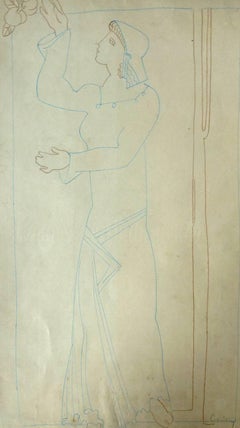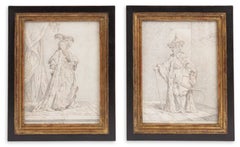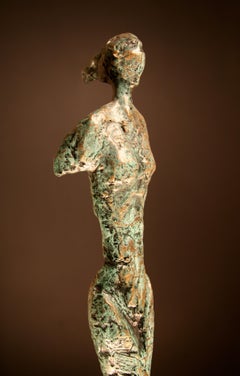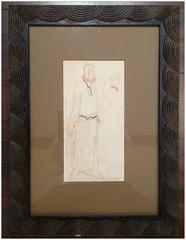Joseph Csaky Art
to
2
Overall Width
to
Overall Height
to
2
1
1
2
2
1
1
1
1
1
2
9,475
2,688
1,375
1,358
1
1
Artist: Joseph Csaky
Signed, Life-Sized, Abstract Figurative, Bronze Sculpture
By Joseph Csaky
Located in Los Angeles, CA
A chic, signed and dated, 1928, cubist style cast bronze sculpture, "L' Etudiente" by highly regarded Austria-Hungarian born artist, József Csáky (1888-1971), who was among the most ...
Category
1920s Joseph Csaky Art
Materials
Bronze
Woman picking Apples
By Joseph Csaky
Located in London, GB
JOSEPH CSAKY 1888-1971
(Hungarian/French)
Title: Woman picking Apples
Technique: Original Hand Signed Coloured Pencil drawing on Van Gelder Zonen paper
size: 42 x 25.2 cm...
Category
20th Century Joseph Csaky Art
Materials
Paper
Related Items
Costume drawings for ‘Ambassadeur de Siam’ and ‘La Sultana Reine’
Located in Amsterdam, NL
Joseph-Marie Vien (1716-1809)
‘Ambassadeur de Siam’ and ‘La Sultana Reine’
Both titled lower centre, the drawing of the ambassador inscribed with colours intended for the prints, e...
Category
Mid-18th Century Old Masters Joseph Csaky Art
Materials
Paper, Pencil
$8,142
H 9.26 in W 6.89 in D 1.19 in
Bronze Sculpture “Arise”
By Frank Arnold
Located in Fresno, CA
Frank Arnold is thought by many to be one of the foremost abstract figurative painters and sculptors of our time. He is a living master whose work is considered to be both personal a...
Category
2010s Abstract Joseph Csaky Art
Materials
Bronze
Bronze Sculpture “Understander”
By Frank Arnold
Located in Fresno, CA
Frank Arnold is thought by many to be one of the foremost abstract figurative painters and sculptors of our time. He is a living master whose work is considered to be both personal a...
Category
2010s Abstract Joseph Csaky Art
Materials
Bronze
Peter Skeolan mid 19th Century English silhouette portrait of a lady
Located in Harkstead, GB
A finely detailed silhouette of a Victorian lady
Attributed to Peter Skeolan (1815-1871)
Portrait of a lady, profile to the right
Watercolour with gold highlighting on paper/card
3¼...
Category
Early 19th Century English School Joseph Csaky Art
Materials
Paper, Watercolor
$248 Sale Price
30% Off
H 3.25 in W 2.75 in D 0.5 in
Self Portrait
By Sándor Bortnyik
Located in London, GB
Charcoal on paper, signed and dated (lower right), 33cm x 24cm, (66cm x 56cm framed). The work is framed behind UV glass and stepped gilded frame.
Bortnyik was a painter and graphi...
Category
1910s Bauhaus Joseph Csaky Art
Materials
Paper, Charcoal
Mid 19th Century English Victorian silhouette portrait
Located in Harkstead, GB
A finely detailed silhouette of a Victorian gentleman.
Attributed Frederick Frith (1819-1871)
The Reverend James Metze, bust length, turned to the left, wearing coat and cravat
wate...
Category
Mid-19th Century English School Joseph Csaky Art
Materials
Paper, Watercolor
$234 Sale Price
30% Off
H 3.25 in W 2.75 in D 0.5 in
Frederick Frith mid 19th Century English Victorian silhouette portrait
Located in Harkstead, GB
A finely detailed silhouette of a Victorian clergyman.
Frederick Frith (1819-1871)
The Reverend James Metze, bust length, turned to the right, wearing coat and cravat
Inscribed to t...
Category
Mid-19th Century English School Joseph Csaky Art
Materials
Watercolor, Paper
$281 Sale Price
30% Off
H 2.75 in W 2.25 in D 0.5 in
Peter Skeolan mid 19th Century English silhouette portrait
Located in Harkstead, GB
A finely detailed silhouette a Victorian gentleman
Peter Skeolan (1815-1871)
Portrait of a gentleman, profile turned to the left, wearing coat and cravat
Watercolour with gold highlighting on paper/card
Stencilled with artist's details to the reverse
3¼ x 2¾ inches, oval, without the frame
5½ x 4¾ inches with the frame
Peter Skoelan the son of Stephen Skoelan was born in Ireland in 1815. During his early career he worked as an itinerant miniature portrait painter and profilist, possibly as early as the 1830s. The 1841 census shows us that he was working in Leeds, his stated occupation was painter, aged 25. He was lodging with Thomas Lacy, a Tailor. By this time he had married and had a son and daughter...
Category
Mid-19th Century English School Joseph Csaky Art
Materials
Watercolor, Paper
$280 Sale Price
30% Off
H 3.25 in W 2.75 in D 0.5 in
French Art, Rococo, Portrait Queen Marie Antoinette France, Oval, Circle Vivien
Located in Greven, DE
French School, Portrait of Queen Marie Antoinette of France, Pastel /oil Pastel on Paper, Rococo, 18th Century. The Pastel is made in the style...
Category
18th Century Rococo Joseph Csaky Art
Materials
Paper, Pastel, Oil
$5,883 Sale Price
75% Off
H 16.15 in W 12.6 in
Mid 19th Century English silhouette portrait of a lady in a night cap
Located in Harkstead, GB
A very skillfully painted ink on paper silhouette, unusually with the sitter appearing to be dress in her nightcap. Very Dickensian!
English School, 19th Century
Portrait of a lady ...
Category
Mid-19th Century English School Joseph Csaky Art
Materials
Paper, Ink
$187 Sale Price
30% Off
H 3.25 in W 2.5 in D 0.5 in
Fabulous Italian Neoclassical Marble Sculpture of Hermes
Located in Rome, IT
19th century French finely chiseled bronze figure of Hermes .
Signed Pigalle G . Cuspinera
Hermes , the messenger of the gods, is sitting on a rock, ready to leap up. He is att...
Category
19th Century Academic Joseph Csaky Art
Materials
Bronze
$6,589 Sale Price
20% Off
H 33.47 in Dm 17.72 in
Large Gilt Bronze Sculptures of Cheetahs
Located in Rome, IT
Fantastic pair of gilt bronze Cheetahs sculptures . The item will be well-suited to either an indoor or outdoor setting.
Category
Early 2000s Modern Joseph Csaky Art
Materials
Bronze
Previously Available Items
drawing, project of a stage costume
By Joseph Csaky
Located in Pasadena, CA
circa 1925,
drawing and watercolour, framed
old collection Rotshchild
Joseph Csaky (also written Josef Csàky, Csáky József, József Csáky and Joseph Alexandre Czaky) (18 March 1888 ...
Category
1920s Art Deco Joseph Csaky Art
Materials
Watercolor
Joseph Csaky art for sale on 1stDibs.
Find a wide variety of authentic Joseph Csaky art available for sale on 1stDibs. You can also browse by medium to find art by Joseph Csaky in bronze, metal, paper and more. Not every interior allows for large Joseph Csaky art, so small editions measuring 4 inches across are available. Customers who are interested in this artist might also find the work of Pierre Ambrogiani, Wladyslaw T. Benda, and Alain BELLINO. Joseph Csaky art prices can differ depending upon medium, time period and other attributes. On 1stDibs, the price for these items starts at $1,000 and tops out at $65,000, while the average work can sell for $10,350.




